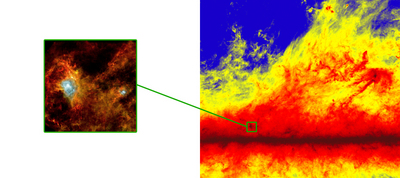 A series of recent experiments has revealed that, more often than not, the halos of dark matter surrounding massive galaxy clusters are flattened and shaped like a cigar. Until now, astrophysicists believed that the mysterious stuff, which is believed to be five times more abundant than regular matter around the Universe, would clump up in rounded spheres. However, observations appear to paint a different picture, and experts are currently working on models that would help explain that.
A series of recent experiments has revealed that, more often than not, the halos of dark matter surrounding massive galaxy clusters are flattened and shaped like a cigar. Until now, astrophysicists believed that the mysterious stuff, which is believed to be five times more abundant than regular matter around the Universe, would clump up in rounded spheres. However, observations appear to paint a different picture, and experts are currently working on models that would help explain that.In the new studies, the investigators looked at about 20 galaxy clusters, which are massive collections of galaxies, held together by strong gravitational interactions. In order to see the effect dark matter has on the largest organized structures in the Universe, the researchers used gravitational lensing. This observations technique analyzes how much light is bent when mass wraps time-space in order to determine the mass of celestial objects beyond. The Mauna Kea, Hawaii-based Subaru Telescope was used for the study, and the team took advantage of the Prime Focus Camera above all other instruments.
“What we're probing with these gravitational lensing observations is the dark matter distribution, because the dark matter dominates the mass on these large scales,” Smith says. The research team in charge of the study was led by National Astronomical Observatory of Japan expert Masamune Oguri and University of Tokyo scientist Masahiro Takada. The cigar-like shapes of these dark matter halos have been predicted in computer models of the cold dark matter theory, but thus far they have not been evidenced in practice in such a large number of galaxy clusters, Space reports.
“Precise measurements of the Cosmic Microwave Background are crucial to cosmology, and to understanding how our Universe formed and evolved. Attaining the highest-sensitivity (a few parts per million), highest-angular resolution (5 arcminutes) maps of the CMB – the goal of the Planck mission – requires the removal of the 'foreground' emission arising from the Milky Way. The information gleaned during this process is providing, as a by-product, a unique view of the processes that led to the formation of the stars in the galaxies that populate our Universe,” ESA officials write in a press release.
Planck maps the sky in nine frequencies using two state-of-the-art instruments, designed to produce high-sensitivity, multi-frequency measurements of the diffuse sky radiation: the High Frequency Instrument (HFI) includes the frequency bands 100 – 857 GHz, and the Low Frequency Instrument (LFI) includes the frequency bands 30-70 GHz. The first Planck all-sky survey began in August 2009 and is 98% complete (as of mid-March 2010).








